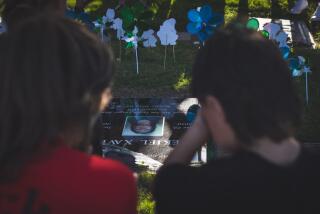Teen’s Death Drives Home Some Lessons : Couple Urge Educators to Look for Suicide Warning Signals
SAN DIEGO — She was a bright, strong-willed, vivacious 18-year-old. She had never been in trouble with the police. She had a boyfriend, a social life and plans for college.
Even so, when the police called at 2 a.m. to say they had found a red Volkswagen on the highest span of the Coronado Bridge, Al Vigil knew that his daughter, Mia, had killed herself.
“I look back now and I see what I missed,” Vigil told about 80 San Diego County educators recently. “I didn’t know she was pregnant. I didn’t know she was doing drugs--a little pot now and then, but that’s harmless, right? I didn’t know she was doing coke and mushrooms.”
In the two years since Mia’s suicide, years so filled with sorrow that Vigil considered “joining Mia to stop the pain,” Vigil and his wife, Linda, have discovered the clues that might have alerted them to their daughter’s desperation and thoughts of self-destruction.
They spoke recently about the signals as part of the San Diego County Office of Education’s efforts to encourage educators to help prevent suicide, the third-leading cause of death among teen-agers. Experts believe that if they could determine how many “accidental” deaths were actually intentional, suicide would be the leading cause of teen-age deaths.
Psychologist Robert Brager told the educators that almost “no suicide is a mystery. No suicide can be explained by the statement ‘I can’t believe it happened.’ Clues are evident in 80% of the cases.”
A youth may give away prized possessions, speak of leaving and never returning, and make statements such as “I can’t take it anymore,” Brager said. Many, but not all, are depressed. They often feel hopeless and helpless, he said.
The Vigils learned after Mia’s death that she had recently lost her job and had aborted a pregnancy several months before. They knew that she had broken up with her boyfriend days earlier, but believed that she was coping well with the situation.
But they were surprised when their daughter, “a girl who would never hurt anyone,” fought violently with a friend, Al Vigil said. And they were surprised, but not greatly alarmed, when she suddenly announced plans to travel to Italy.
“She put her arms around me and said, ‘Mom, promise me you won’t be mad at me forever,’ ” Linda Vigil remembered.
But the Vigils “had no idea she was suicidal,” Al Vigil said.
Suicidal people are not seeking death, but attempting to halt an intolerable pain from which they see no escape, the educators were told. In the mind of the sufferer, the alternatives have been narrowed to two: interminable pain or death.
“The idea of cessation is viewed as the only solution, the best alternative,” Brager said.
Despite myths that have evolved about suicide, it is not more common among any socioeconomic group. The tendency is not inherited, not associated with mental illness and not provoked by asking an individual if he is thinking about committing it, Brager said.
He asked educators to overcome the historic squeamishness about the subject by discussing it in their schools.
“What we’re imploring you to do is talk to other people and give them the opportunity to talk about pain . . . so we can give them the opportunity to live on,” Brager said.
Al Vigil said: “If you know anyone who needs to be talked to about suicide, ask them. And if you can’t do it, call me. And I’ll ask them.”
More to Read
Sign up for Essential California
The most important California stories and recommendations in your inbox every morning.
You may occasionally receive promotional content from the Los Angeles Times.










